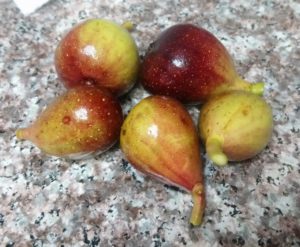The beginning of fall is a time to celebrate figs, with many southern varieties producing a profusion of tasty morsels that enliven our home plate. I view figs as a ‘standard’ southern fruiting tree, easy to grow and most folks that I have spoken with either having a fig tree in their backyard growing up or currently enjoying the fruit of their labor.

Fig ‘Italian Black’
Fig (Ficus carica) are considered a classical fruit, a prized sweet-tasting commodity celebrated from ancient western Asia to Mediterranean civilizations. Figs were imported to California from Spain in the mid eighteenth century, making their way across the southern United States with colonial expansion. Our region has a history with figs, supplying a good portion of national fig distribution during the turn of the 20th century. Canneries could be found in Brazoria and Galveston County towns such as Alvin, Angleton, Pearland, Alcoa, Friendswood, San Leon, Winnie and La Porte with between 17,000 to 18,000 acres under cultivation by the early 1920s. Fig production declined shortly after World War II, with regional commercial production ceasing soon after.
An elderly friend of mine would say ‘you don’t know where you’re going until you can tell where you’ve been’. Taking off this wisdom and providing you with a historical note, I found a few publications I’m getting through during the holidays that have significance in my journey with figs. Edible Figs: Their Culture and Curing by Gustav Eisen (Curator in Biology, California Academy of Sciences, San Francisco, CA) and Fig Culture In the Gulf States by Frank S. Earle (Horticulturist, Alabama Experiment Station, Auburn) is a compilation in book called Fig Culture. These combined articles were published by the U.S. Department of Agriculture, Division of Pomology in 1897, reprinted 11/18/2019 (Copall, TX; ISBN 9781539534396) and gives us a glimpse of fig culture at the turn of the century. I’ll post about a few other publications in my ‘to read’ list that were published ca. early 1900’s at another time.
With a little preparation, figs can be grown quite successfully in the home landscape. Fig trees are generally not cold tolerant, limited to regions with mild winters well above minimum 10-degree temperatures. While they are adaptable to soil type, figs should be planted in well-drained soil. Keep in mind that fig trees have fibrous, shallow root systems and must be protected from water loss, winter temperature fluctuation and soil compaction with an adequate mulch layer. Fig trees can get quite large and are often grown as spreading, multi-trunk specimens. Space them in your orchard at minimum 12-feet apart. The best plan is to locate them with full sun exposure in an area of your yard.
Fruit production may begin when an established tree reaches 2 years old. There are four fruiting forms that include Caprifig, San Pedro and Smyrna, and the one most successfully grown in our region is called Common. Fruit on the common form develop without pollination (parthenocarpic). The fruit is an enlarged, fleshy hollow stem tissue enclosing masses of tiny flowers. Characteristics to consider when choosing a fig tree are varieties producing fruit with a closed, or nearly closed eye. The eye is a small opening located at the bottom of the fruiting structure. Open eye varieties may be susceptible to insect infestation such as the dried fruit beetle and fungal pathogens. Fruit harvest can occur from early through late summer in our region. Figs must be harvested when ripe and will not continue to ripen once picked, prompting preservation via canning or drying with a bountiful harvest.
While there is not enough room in this article to list a wide variety of fig trees, I will address some that will work for you. ‘Brown Turkey’ and ‘Texas Everbearing’ are two varieties that produce well, and the two are often confused with one another. ‘Brown Turkey’ is a common home-grown variety and can provide up to two harvests in a year (late May-June, and September – November), producing a small to medium fruit with a nearly closed eye, violet brown skin and sweet red-amber colored pulp. ‘Texas Everbearing’ can also produce two annual crops of medium to large-sized figs with a moderately closed eye, succulent brown-purple fruit with deep burgundy pulp, ideal for canning or eating fresh. ‘LSU Purple produces a medium-sized green to dark-purple skin with strawberry colored pulp that is mild and sweet-flavored. The fruit has a closed eye and is reported to be relatively cold hardy and widely adapted across the Gulf Coast. You may try ‘Italian Black’, a large fruit with glossy black skin and deep red flesh known for its flavor and reliability. It can produce early in spring (called ‘breba crop’) from old wood and will produce hefty crop in fall on current year’s growth.
I consider fig nature’s candy, a fruit high in natural sugars, minerals and soluble fiber. Information about fruits and vegetables support the Texas A&M AgriLife Extension Service initiative Path to Plate, a research-based education program that helps consumers understand how food choices impact their health. Browse to our Brazoria County AgriLife Horticulture website for info about upcoming programs: https://brazoria.agrilife.org/horticulture/, you can always email me directly with any gardening questions at: [email protected], and I look forward to seeing you in the garden.

